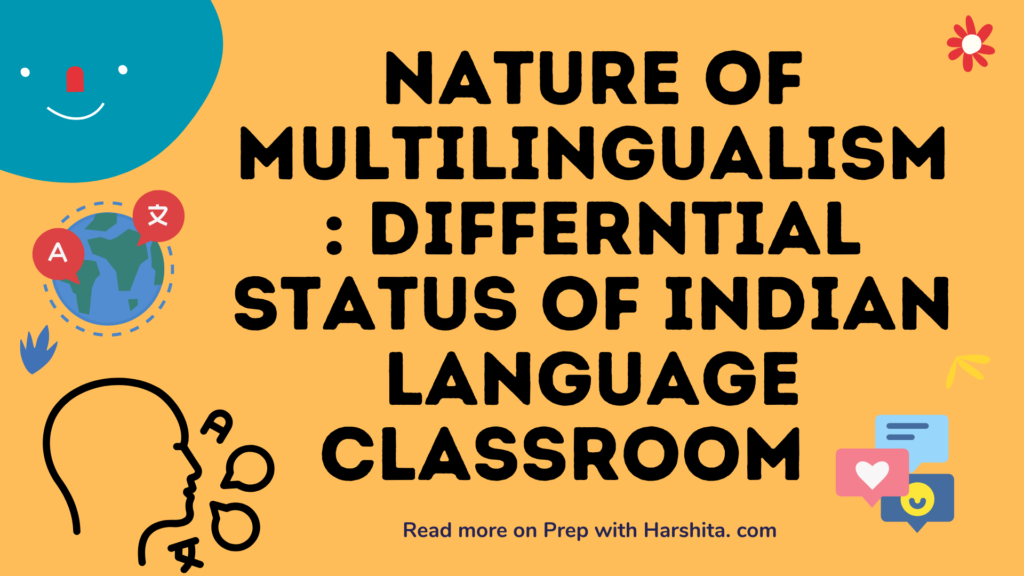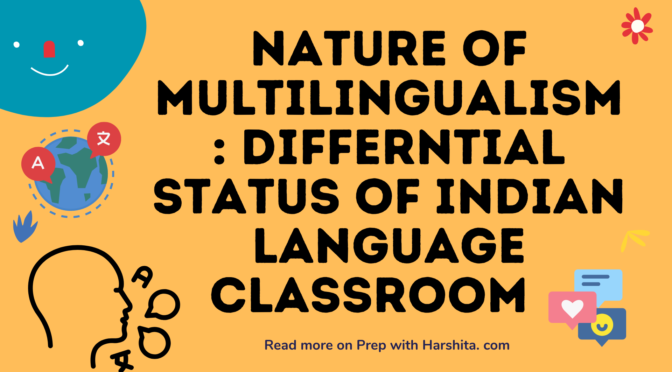In the Indian context, the nature of multilingualism in language classrooms is influenced by the differential status of Indian languages. India is a linguistically diverse country with hundreds of languages spoken across its various regions. While the Indian constitution recognizes few officially recognized languages, there are several other regional and minority languages spoken by different communities. Let’s try to understand Nature of Multilingualism : Differential Status of Indian Language Classroom.
Let’s discuss about them :
- Official Language Policy: The Indian government has adopted a three-language formula that encourages the study of three languages in schools. Typically, schools teach the regional language, Hindi (as a national language), and English. However, the implementation of this policy varies across states and educational institutions. The status and emphasis given to each language in the classroom may differ depending on the linguistic and cultural context of the region.
- Dominance of English: English holds a prestigious status in the Indian education system and society at large. It is often seen as the language of opportunity, social mobility, and global communication. English-medium schools are considered prestigious, and proficiency in English is often associated with better educational and employment prospects. Consequently, English tends to receive more focus and resources in language classrooms, sometimes at the expense of regional languages.
- Regional Language Emphasis: In many regions of India, there is a strong emphasis on teaching and promoting the regional language. State governments may prioritize the regional language by using it as the medium of instruction in schools and providing resources for its teaching. Regional language education aims to preserve cultural heritage, foster regional identity, and ensure access to education for students who may not have a strong command of English.
- Disparities in Language Resources: Disparities in language resources and support can exist across Indian languages in the classroom. English and certain major regional languages may have more textbooks, learning materials, and qualified teachers available, while minority languages or languages spoken by marginalized communities may face a lack of resources. This differential status can impact the quality of language instruction and opportunities for language learning.
- Bilingual and Multilingual Instruction: In many Indian classrooms, bilingual or multilingual instruction is common. Teachers may use a combination of English, Hindi, and the regional language to deliver instruction. Code-switching and code-mixing between languages may also occur, depending on the language proficiency of students and the teacher’s language policy. This dynamic language use reflects the multilingual nature of the Indian society.
- Language Attitudes and Perceptions: Students and parents may have varying attitudes and perceptions towards different languages in the classroom. English is often associated with social prestige, while regional languages may face stigmatization or be viewed as less valuable in terms of career prospects. These language attitudes can influence language choices, language learning motivation, and the overall language dynamics within the classroom.
- Cultural and Linguistic Diversity: The Indian language classroom reflects the rich cultural and linguistic diversity of the country. Students from different linguistic backgrounds come together, bringing their unique languages, dialects, and cultural perspectives. This diversity can create opportunities for language and cultural exchange, fostering intercultural understanding and appreciation.
It is important to promote equitable language education policies and practices that value and support all Indian languages in the classroom. Recognizing the importance of multilingualism and providing resources for the teaching and learning of regional languages can contribute to preserving linguistic diversity, promoting inclusive education, and empowering students to navigate the multilingual landscape of India.
Also Read : Multicultural Awareness

Also Visit : Prep with Harshita

